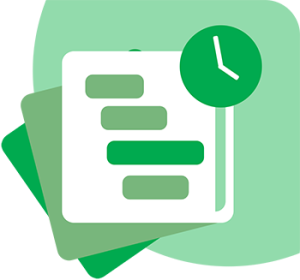A mortgage interview in 2024: come prepared!

You’ve spotted your dream home! And the great thing is … it’s for sale. That means you can live there. But before that happens, there are quite a few steps to take. Especially around applying for a mortgage. That can be quite complicated, and besides: what all do you need to prepare? In this article, I will help you get started on how to be well prepared for your 2024 mortgage interview.
By Maaike Verhoef, licensed mortgage planner
Mortgage interview: what are your financial options?
When you’re looking for your first or next home to buy, a search process begins with delving into your financial options. When you know the amount you can borrow and afford, you can search more specifically for your dream home.
What can you pay per month?
When you want to take out a mortgage, there are 2 standards that are important.
- What can you borrow according to the bank’s standards(maximum mortgage according to the code of conduct for mortgage lenders) and
- What amount can you borrow that fits the expenses you want to start paying per month.
Among these, point 2 is the most important. An important question to ask yourself: what are you willing to pay each month in housing costs and what can you save? If we have a mortgage discussion together, I will definitely address this as well. It is smart if you already have an idea about this for yourself when you meet with a consultant.
Don’t have a clear understanding of your monthly income and expenses? Then you can use online tools for this purpose. See, for example, this budget form in which you can properly chart your monthly income and expenses.
Also remember that you still need to be able to save. A savings buffer is always important to have. Especially when you own your own home, this is indispensable. On the NIBUD website you can calculate what you should have in your situation in terms of your own money. Assume the new situation that you have an owner-occupied home.
Mortgage interview: an initial introduction
For a first introduction, not a lot of data is needed yet. In this conversation, you will meet your advisor and receive an indicative calculation that suits your situation and capabilities.
For this conversation, it is helpful to have the following information available:
- Last paycheck
- Any completed employer’s statement
- If you already have a mortgage (or had a mortgage before) then the details of this mortgage are also needed. Consider the offer you signed at the time + a document with current mortgage debt details.
- Details of any loans(revolving credit, expiring credit, student debt, private lease, overdraft, credit card, installment phone, loan from family or another person)
At BKR (Bureau Krediet Registratie) you can see what is registered in your name for free. For this, see this link.
Employer Statement
The employer’s statement is important to include in the first interview in case: you do not yet have a permanent contract or when you have varying income (think overtime, irregularity pay). Do you have a permanent contract and fixed income? Then the employer statement can be provided later at the time when you actually bought a home. The employer statement is only valid for a limited time (3 months).
Are you buying a home with a partner? Then the above documents also apply to your partner.
Cost
Most counselors cover the cost of the initial introduction. The consultant will talk a little about his services and associated costs. Before the actual assignment, you must sign an order for services that contains all the agreements.
Most advisors will also give you an initial sample calculation of your mortgage and the monthly costs involved. You will make this sample calculation together in this conversation. In it you will see all the additional costs listed for taking out a mortgage, as well as the monthly charges you will have once the mortgage is completed.
What other topics are covered?
If you join hands with the appropriate advisor after the orientation meeting, subsequent conversations will look in detail at:
- What do you want to pay monthly and then what is the amount you can borrow. Importantly, these monthly payments also allow you to save monthly.
- What are the fees you will have to pay when taking out a mortgage? Consider:
- Transfer tax 2%(unless you are entitled to a start-up exemption). This one is not tax deductible.
- Notary mortgage deed fees (fees you will have to pay to the notary for closing the mortgage). The cost is about €700 and it is tax deductible.
- Notary delivery deed fees (fees you have to start paying to the notary to get the property in your name). The cost is about €700 and is not tax deductible.
- Appraisal fees, unless your situation also allows for a desktop appraisal. With a desktop appraisal, you pay a lot less cost because the appraiser does not go by the property that needs to be appraised. Only this is not possible in all situations and with all mortgage lenders. The cost of a normal appraisal is about €700 and is tax deductible. The cost for a desktop appraisal is about €85.
- Advisory fees for the advisor who helps, guides and advises you throughout the mortgage process. Think between €2500 and €3000. However, these costs are tax deductible.
- Cost National Mortgage Guarantee when you qualify for it. In 2024, this can only be done for homes up to €435,000. The one-time fee is 0.6% on the amount you borrow and is tax deductible.
- Cost buying agent when you hire one. The cost is about €1000 to €2500. These costs are not tax deductible.
- Cost building inspection. As a buyer, you have a duty to investigate. Thus, it is important to have the home structurally inspected. This is also 1 of the conditions you can set with your bid. The cost is approximately €500 and is not tax deductible.
Energy Label and Making Your Home Sustainable:
Since 01-01-2024, the energy label also determines the amount of your maximum mortgage on your income. The better the energy label the more extra borrowing room you have for your mortgage. This extra amount you can borrow on your income can be as much as €50,000 for a house with guaranteed no energy costs.
- E/F/G: €0
- C/D: €5,000
- A/B: €10,000
- A+ through A++: €20,000
- A+++: €30.000
- A++++: €40.000
- A++++ with guarantee: €50,000
Additional borrowing for home preservation:
You can also borrow an additional amount to make your home more energy efficient. For this, there is a list of measures that almost always reduce energy bills more than they increase monthly mortgage payments. Because homes with an energy label of E/F/G require more to make the home sustainable, buyers of this home can borrow a higher amount extra to make it more sustainable than a buyer of a home with an energy label of C/D or higher.
- E/F/G: €20,000
- C/D: €15,000
- A/B tm A+++: €10,000
- A++++: € 0
Fact: of the expenses that are tax deductible, you get about 30% back from the IRS.
Bidding on a property
When you want to start bidding on a property, you can do two things: either hire a buying agent or do the negotiations yourself. When you hire a buying agent, you pay the agent a fee for the help he/she provides you. The buying agent will negotiate for you, determine with you the offer and conditions, and in addition you will get help in checking the purchase contract.
If you are going to negotiate with the selling broker yourself, then you must also determine the offer yourself.
In this situation, always check what the WOZ value of the property is ( see also this website ). Perhaps a desktop appraisal ( see here ) can assist you in determining the bid. Furthermore, it is wise to make the offer in writing by email so that your terms are also fixed.
What is a mortgage and what forms do you have?
A mortgage is a loan to buy a home with. When buying a home, you borrow money from the bank and use it to finance your dream home.
Each month you pay mortgage charges that consist of 2 components:
- Interest on the debt you still have outstanding
- Redemption
Tax deductions
The mortgage interest is tax deductible each month provided you meet the tax game rules. For example, it must involve the purchase of your own home that you will also live in yourself.
For new mortgages, since 01-01-2013, you are only eligible for mortgage interest deduction if you repay the mortgage on an annuity or straight-line basis in 360 months. In this way, your financial risk becomes smaller every year: your debt decreases, and thus you also reduce the risk of payment problems or residual debt.
If you already had a mortgage before 01-01-2013, the old tax rules may still be in effect for you. Should you decide to take out an additional mortgage(for example, for remodeling or when you buy a new home), the new rules always apply to the new piece of your mortgage.
Mortgage Types
You have a choice of mortgage types. The most common are these three:
Annuity mortgage
With the annuity mortgage, gross monthly payments remain essentially the same throughout the term. But over the years, the structure of monthly expenses does change. In the beginning you pay a lot of interest and little repayment, and at the end it is exactly the other way around. As you pay less and less interest, the tax benefit becomes less and less. As a result, your net monthly expenses will gradually increase
Linear mortgage
This form of mortgage is similar to an annuity mortgage with one important difference; the monthly charge decreases over the term. A feature of a linear mortgage is that the repayment remains the same during the term. As a result, you pay less and less interest and the tax benefit becomes less and less, with the result that your gross and net monthly expenses will gradually decrease.
Repayment-free mortgage
An installment-free mortgage is a type of mortgage where you pay only interest until the end date. Because you don’t repay, you have to pay off the loan in one lump sum at the end date or roll it over into a new mortgage. Your mortgage debt remains the same throughout the term unless you choose to repay in the interim. A mortgage usually runs for 30 years.
Because for new mortgages, a mortgage is only tax-deductible if you also repay it, an interest-only mortgage is only tax-deductible if you fall under the transitional law.
Combination
You can also combine the above mortgage types. Your loan will then be cut into 2 parts. One loan part gets one mortgage form and the other loan part gets another mortgage form.
Mortgage interview: you bought the house! And now?
When you decide to buy the home and take out a mortgage, the advisor will look at several important issues with you. In the end, you apply all aspects to your situation. Consider:
- What type of mortgage do you want to take out and best suits your situation?
- How long do you want to fix the interest rate?(Usually the longer fixed the more expensive)
- Can you still pay the monthly expenses even if you have a long-term illness or lose your job? For example, do you want to insure this risk and what are the costs for such insurance?
- What is the situation when your partner dies? What own income do you have then? Will you receive a survivor’s pension and what can you pay in mortgage payments in that situation? Do you want to insure this risk, and what is the cost of such insurance?
- Are you 37 years old or older? Then you will reach retirement and state pension age within 30 years. So is a 30-year term still wise or should you pay off the mortgage in a shorter period of time so that your usually lower retirement income will still allow you to make monthly payments?
- Are you buying with a partner? Who brings in what in their own money and who pays what in monthly expenses? What should be settled should you possibly separate?
- Do you have a desire to have children? It is important to be able to pay your monthly expenses even when expenses and income change.
A good advisor
Are you looking to buy a home and need help and advice? A good advisor is good value! An advisor saves you from pitfalls and unnecessary costs and thinks with you. Please feel free to contact me for an appointment. Click here for the contact button.





